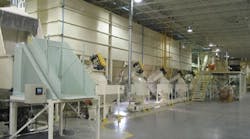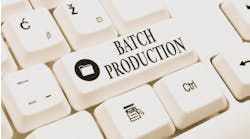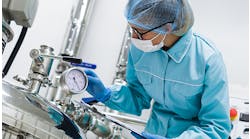Wellington Polymer Technology Inc. (WPTI) in Chatham, Ontario, embraced the chemist's vision and spent six years developing the Enviroshake shingle. Premium, high-tech roofing, the product replicates the look of an antique cedar shake roof with the added benefits of increased durability, ultraviolet protection, wind and hail resistance, and superior mold, mildew and insect resistant properties.
Moving Production Upscale
In order to move from concept to production, WPTI needed to upgrade its small-scale, prototype production line to an automated, commercial operation. In 2001, the company made the transition using an integrated control platform. With engineering expertise from Oxford and Ewing Engineering Inc., and hardware and software from Rockwell Automation, we increased our output from 20 shingles per man-hour to 180 shingles per man-hour, while consistently meeting our high product quality requirements.
Fast and Flexible Process
Wellington Polymer Technology Inc. transitioned from it's small-
scale prototype production line to fuly automated, commercial
operation (shown here) and in the process significantly boosted
throughput.
The Enviroshake manufacturing process consists of three stages"compounding, processing and packaging. The innovative shingle is made from raw, reclaimed materials including post-industrial plastics, ground rubber from tires, hemp, wood and flax fibers. These materials are mixed, melted and molded into shingle forms. From this point, the shingles are trimmed, cooled, inspected and stacked for bundling.
After designing the initial concept and manufacturing process for Enviroshake, WPTI engineers found that simply replicating the initial pilot line on a larger scale would require more than 35 people per shift to operate the line. To ensure the economic viability of the product and meet our business objectives, we needed to reduce labor costs, and at the same time, achieve an output goal of 50 squares per day (one square equals 100 square feet of product).
Time to Automate
It quickly became apparent that we had to transition from our labor-intensive, manual formulation process to an automated production line that could be operated and maintained with minimal labor and maximum efficiency. Key to this evolution was finding control system technology that would provide ease of use for operators, simplify troubleshooting and reduce downtime.
So we set out to automate the facility. The company's goal for the project was to create a process that was flexible enough to meet both immediate and long-term needs, as well as product throughput demands. The ability to coordinate effectively coordinate several mini-processes would play a major role in meeting these requirements.
After researching and evaluating a number of solutions, WPTI became interested in the multi-discipline capabilities of the Allen-Bradley ControlLogix programmable automation controller (PAC). (PAC is a generic term used to describe a breed of controllers that combines multiple platforms, such as sequential, motion and process control. PACs, like ControlLogix, combine the best attributes of the PLC, PC, DCS and open control platforms to meet the requirements of an integrated manufacturing enterprise.)
Today, we have an automated line that consists of two separate systems"compounding and processing"each controlled by its own PAC and connected to one another via Ethernet.
Here is how the process is currently configured: Within the compounding system a ControlLogix controller, linked to four separate operator interface terminals via ControlNet, handles the control functions, beginning with raw material receiving and storage. All Enviroshake raw materials are barcoded after passing a quality assurance/quality control (QA/QC) check. Before entering storage, each container is scanned to check for QA/QC acceptance and control the distribution slide gate to ensure materials go into the proper storage bin. Storage levels are monitored using an ultra-sonic transducer system interfaced through DeviceNet.
Batching the Materials
Batching is the second stage in the compounding operation. During this process, each material is fed into its own weigh scale and is measured using a load cell/scale system. Once material weight reaches 90% of the given total, the feed is slowed down using Allen-Bradley drives to ensure accuracy. Once all material is ready, it is conveyed to the blender. The recipe is the same for every batch. However, fine tuning can be done from a password-protected supervisor's screen on the operator interfaces.
Once the material reaches the blender, it is staged in hoppers above the blender. The hoppers act as scales and are used to verify the weight of each batch. If there are any discrepancies, an alarm shows on the control screen. After one blender cycle is complete and blended material is dumped, the material in the hoppers is dumped into the blender, initiating another cycle. The blended material is conveyed from the blender via a variable-speed screw conveyor powered by its drives. The speed is varied to maintain constant amperage on the pelleting machine. After the shingle material is pelleted, it is conveyed to storage.
In the processing system, all of the I/O and system devices are connected to the ControlLogix controller via DeviceNet. Material from the compounding process is fed into an extruder hopper, and the extruder melts and mixes the compounded material. The extruder has several temperature zones that are controlled through temperature controllers. Each controller uses an internal proportional-integral-derivative (PID) system to heat or cool as required to maintain a set temperature. When material exits the extruder it goes through several molding, trimming and cooling processes. At this time it is transferred using DeviceNet robots and variable speed conveyors driven by PowerFlex 70 drives. The final part is a tapered shake that gets stacked into bundles, each containing 26 parts.
Production Up, Labor Down
After installing the automated control system, we increased production from 20 parts per man-hour to 180 parts per man-hour and reduced labor by 83%. The system also enabled the company to meet consistently the production output goal of 50 squares per day.
That's because the PAC-driven architecture simplified operational tasks and greatly reduced manpower needs at WPTI. The ability to program, operate and monitor the production line from multiple locations, allows our operators to minimize manual tasks, while boosting product delivery capabilities.
The integrated control platform also allows us to reuse the technology from one production line to the next, simplifying engineering tasks and improving operational efficiency. Plus, programmers have a complete visualization package to easily develop and test HMI screens. The user-friendly graphical interface ties directly into the production system to help simplify operation and accelerate troubleshooting.
But what matters most is the ability to meet throughput needs. And on average, we achieved a 300 percent increase in overall production, with the flexibility to expand the line to meet increased market demands. The plant currently operates one production line with the ability to expand to five lines and plans to add a packaging cell to the line in the near future.
Utilizing the integrated capabilities of a PAC, WPTI was able to design and install an affordable production line that meets business goals, and provides customers with the highest level of flexibility and quality. That puts us in a position to meet demand and exceed expectations as the Enviroshake concept gains popularity, protecting more and more homes from a repeat of the tragedy in California.
Jim Waters, Vice President of Operations, Wellington Polymer Technology, Inc. can be reached at 519/380-9265.



